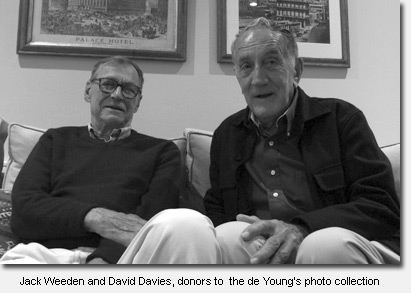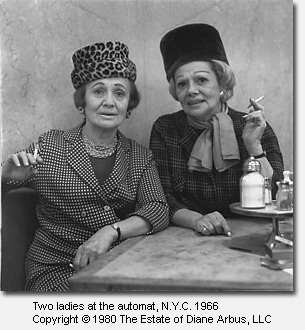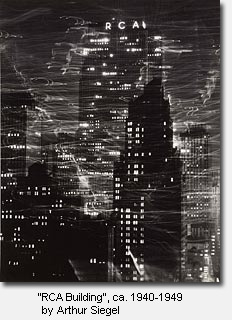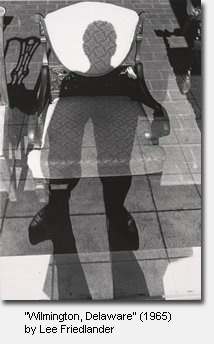Normally when I go to a museum, I look at the title card next to a piece, read the description, and then gloss over the name of the owner/donor since it very rarely means anything to me.
This changed recently when some family friends, David Davies and John (Jack) Weeden, donated their photography collection to the de Young Museum. Their pieces comprise the majority of an exhibit that opened in June called “Toward Abstraction: Photographs and Photograms”, which features the work of Edward Weston, Arthur Siegel, Harry Callahan, Lee Friedlander, Imogen Cunningham, and Robert Mapplethorpe.
I sat with them recently to talk about the de Young show and their passion for collecting.
————————————————–
 David Davies and Jack Weeden are collectors. Their passion for it has covered many genres of art and objects, ranging from antique weather vanes to automobile hood ornaments to doorstops.
David Davies and Jack Weeden are collectors. Their passion for it has covered many genres of art and objects, ranging from antique weather vanes to automobile hood ornaments to doorstops.
Of the two, Davies is the more passionate and competitive about collecting, and says “when you see something and you think it’s great, you have to have it. It’s a search and once it’s in your possession, the game is won”.
Their interest in photography began in the 1970’s, when they struck up a friendship with Jeffrey Fraenkel, a tenant in a building that they owned. Fraenkel was just opening up his now world famous Fraenkel Gallery in San Francisco, and Davies was intrigued by the photographic art.
Specifically, David wondered how one photograph could be next to another, both nearly identical, and one is worth a lot of money, but the other is not.
Fraenkel explained the difference between a vintage photo and a regular photo. A vintage photograph is more valuable because it’s developed, printed and signed by the photographer at the time it was taken. And it’s never printed again. He told David that if he was going to get into collecting, “you should only deal in vintage”.
Davies was intrigued but a little put off by the artificial hierarchy of photography collecting. At the time he thought, “This is ridiculous, I can’t tell the difference between vintage and regular”.
Nevertheless, he heeded Fraenkel’s advice and another collection began to accumulate in the Davies/Weeden household. They didn’t know at first that their real passion would lie with abstract photographs, and some of their early acquisitions tended toward representational photography.
 Their first collectible was a print of “Two Ladies at the Automat”, a 1966 photo by Diane Arbus. Even after twenty plus years of collecting photographs, it remains Davies’ favorite (note that this photo is not in the de Young show).
Their first collectible was a print of “Two Ladies at the Automat”, a 1966 photo by Diane Arbus. Even after twenty plus years of collecting photographs, it remains Davies’ favorite (note that this photo is not in the de Young show).
The foundation for their abstract photography collection came via a fortuitous rejection from the Getty Museum. In the early 1970’s when the museum was preparing to open, an art dealer in Chicago presented a series of Arthur Siegel photographs for their new photography department. The Getty turned it down and after viewing it, Davies and Weeden bought the collection for themselves. Davies says “at the time, [Siegel’s work] was not too recognized”.
There are many Siegels in the de Young show, including several of the artist’s photograms. Taking abstraction to the extreme, a photogram “is a photographic image made without a camera by placing objects directly onto the surface of a photo-sensitive material such as photographic paper and then exposing it to light” [Wikipedia]. Interesting shapes, shadows and light play across these pieces in the show.
The “Toward Abstraction” show also features a few photographs by Robert Mapplethorpe, a controversial artist best known for his erotic, sometimes shocking photography.
One piece in the show, entitled “Thomas (Back)”, shows the back of a man’s muscular torso, with linear shadows falling across it. This is one of Weeden’s favorites, as he explains that “just as you might like a Greek statue, it’s a beautiful shot of the body”.
Davies and Weeden met and befriended the late Mapplethorpe, here in San Francisco while he was showing at the Fraenkel Gallery, and another time in New York.
While in New York, Davies invited Mapplethorpe to join them at their weekend farmhouse to which the photographer replied “That’s very nice and I probably would enjoy it. But you know, I’m dying and I really don’t have time for new friends”. Davies chuckles at the memory and says “Now, what do you say to that?”
 If there is any theme to their collection apart from abstraction, it’s the city of New York. Though the two call San Francisco their home, they keep a second home in New York and travel there often. “Atom Bomb Sky, New York City (1955)” by William Klein is a photograph of the city from high over midtown, with a blistering sun that casts eerie shadows over the cityscape.
If there is any theme to their collection apart from abstraction, it’s the city of New York. Though the two call San Francisco their home, they keep a second home in New York and travel there often. “Atom Bomb Sky, New York City (1955)” by William Klein is a photograph of the city from high over midtown, with a blistering sun that casts eerie shadows over the cityscape.
Another photograph entitled “Right of Assembly (1939)” by Arthur Siegel looks from afar like a series of white dots on a black landscape. Up close you realize it’s a crowd shot of hundreds of United Auto Workers taking part in a union strike in Siegel’s hometown of Detroit, Michigan. It’s this element of “what you see is not always what you get” that makes this collection so interesting.
Another multi-layered and well known photo in the show is “Wilmington, Delaware (1965)” by Lee Friedlander. On first glance it’s a simple photo of an armchair in the sun. Viewed more closely, it becomes a self-portrait of the artist as his shadow falls across the frame and his shoes are reflected in the storefront glass, as if he’s sitting in the chair.
Friedlander’s photo is an example of Davies’ love affair with shadows in photography. “I love shadows, you’ll see many of them in these photographs where the figure is in the shadows and it’s competing with the images themselves”.
What comprises Davies’ and Weeden’s collection has more to do with what moves them than what’s popular in the world of photography. When asked what made him pick a particular photo, Davies replies “I just like that photograph, it doesn’t have anything to do with whether it’s a renowned artist. I just love the print”.
Their collection is comprised only of black and white photography. “Never collected anything in color, it’s a whole other world” Davies explained.
 After a couple of decades, Davies and Weeden found that their collection was bigger than they could reasonably enjoy. While many collectors painstakingly rotate the art in their homes, the pair soon tired of the task and decided that what was on the walls would just stay there; the other pieces would stay in storage.
After a couple of decades, Davies and Weeden found that their collection was bigger than they could reasonably enjoy. While many collectors painstakingly rotate the art in their homes, the pair soon tired of the task and decided that what was on the walls would just stay there; the other pieces would stay in storage.
As a result, some of the photos donated to the de Young arrived wrapped in their original brown paper from the galleries where they were purchased. The two are still surprised by some of the pieces they see in the exhibit. During a recent visit to the de Young, Davies pointed and said “Good god, is this one ours?” and Weeden replied “Yes, it says so on the card!”.
Davies and Weeden continued collecting into the early 1990’s, until prices for vintage photographs “became ridiculously expensive”. The bulk of their collection was purchased from the Fraenkel Gallery here in San Francisco.
All told, their collection includes just over a hundred photographs. Seventy five were given to the de Young, of which only about two dozen are in the “Toward Abstraction” show, along with selections borrowed from the Paul Sack Photographic Trust.
Eventually the balance of their collection will go to the de Young as well. But, Davies says with a chuckle, “I have to die first”.
“Toward Abstraction: Photographs and Photograms” runs until November 15, 2009 at the de Young Museum in Golden Gate Park.
Special thanks to David Davies and Jack Weeden for making this article possible.
Sarah B.
Great article. The show is a must-see.
As a photography buff, particularly “old skool analogue”, this is a fascinating look in the “eyes” & thoughts of a collector. I have yet to see the exhibit but I am now more excited to do that. I can see why the Diane Arbus photo is one of their favorites as it’s a timeless photo that tells a story.
Thank you thank you for the interview.
Thanks, John for stopping by and leaving your nice comment. I’m glad this got you more excited about the show. As a buff, I’m sure you’ll really enjoy it!
Sarah B.
I went to the De Young to see the Tut exhibit and was awe struck by this photography show… if you like B&W abstract photography you have to make the time to see this show. Thank you for this article as it was such a treat to put some history to the collection.